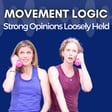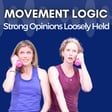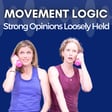
78: Behemoth Knee Myths
Welcome to Episode 78 of the Movement Logic podcast! In this episode, Laurel and Sarah discuss what current science, versus outdated advice and conventional wisdom, have to say about the knees—namely whether “bone on bone” is a thing, and if deep squats, knee valgus aka “knee cave”, or high impact are inherently bad for your knees. Learn what research has to say about some of the most common fragilizing beliefs people hear about their knees, and why these scary tales are just plain wrong. In this episode you will learn that:
- The knee is strong and adaptable, capable of handling various loads with training.
- The knee has a wide range of safe positions, especially with progressive exposure.
- Knee pain doesn’t always mean injury, and injuries can heal with proper care.
- The knee isn't a simple hinge; it allows rotational and lateral movement.
- The kneecap doesn’t always need to face forward in standing.
- Knees can lock or hyperextend without causing harm, depending on the person.
- The knee can safely move past the ankle and toes during squats or lunges.
- Running and landing don’t require the knee to track perfectly forward.
- Knee valgus is not inherently dangerous.
- Deep squats, high-intensity exercise, and running do not cause arthritis or "wear and tear"; they strengthen the knee.
- Strength training and running thicken knee cartilage compared to inactivity.
Sign up here for our FREE Live Strength Class (and sample our Bone Density Course) on September 19th at 8:30am PT/11:30am ET with free replay!
Analysis of the load on the knee joint and vertebral column with changes in squatting depth - PMID: 23821469
Positive effects of moderate exercise on glycosaminoglycan content in knee cartilage - PMID: 16258919
Thickening of the knee joint cartilage in elite weightlifters as a potential adaptation mechanism - PMID: 24648385
Exercise for osteoarthritis of the knee: a Cochrane systematic review - PMID: 26405113
Knee alignment does not predict incident osteoarthritis - PMID: 17393450
Gluteal muscle weakness on joint kinematics - PMID: 37309814
The effect of experimentally induced gluteal muscle weakness on joint kinematics - PMID: 37309814
Impact of Three Strengthening Exercises on Dynamic Knee Valgus - PMID: 34068810
Anteromedial versus posterolateral hip musculature strengthening with dose-controlled in women with patellofemoral pain - PMID: 33689989
Kiss goodbye to the 'kissing knees' - PMID: 33906580
Research on Crossfit injury risk - PMID: 24276294, PMID: 28253059, PMID: 32343082, PMID: 33322981
Instagram post about Sharon Lokedi


